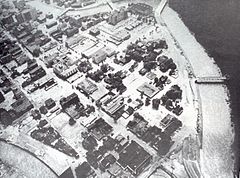Johnstown flood of 1977

Panoramic view of the flood.
|
|
| Date | July 19, 1977 to July 20, 1977 |
|---|---|
| Location | Johnstown, Pennsylvania area |
| Deaths | 84 |
| Property damage | US$117 million: Johnstown; $213 million: Surrounding areas |
The Johnstown flood of 1977; also known as the Second great flood of Johnstown, and the Johnstown disaster, began on the night of 20 July 1977 when flash floods hit the area of Cambria County, around Johnstown, Pennsylvania and the Conemaugh Valley. Nearly twelve inches of rain fell in twenty-four hours, when a thunder storm stalled over the area. With the failing of six area dams nature was able to do what area residents had been convinced could not happen again.
Ron Shawley, executive director of Laurel Highland's Historical Village, returned to Johnstown on the 20th and stated "It was like somebody dropped an atomic bomb on Johnstown", "I questioned what kind of force it would take to do that.".
After the Johnstown flood of 1936, the Army Corps of Engineers began a study and work started in August 1938 with extensive dredging and flood control measures. On November 27, 1943, Colonel Gilbert Van B. Wilkes, Chief of the Army Corps of Engineers, Pittsburgh District, told a Johnstown audience the flood problems had been effectively solved. People began to feel secure that any flooding issues had been resolved and even promoted the area as "flood free" for many years. The Corps of Engineers had designed flood control measures for protection of a standard project flood. Protection to the 500 year level was not economically viable. In 1974 the Corps issued a report titled "The Potential for Future Flooding in the Johnstown Area". This did not deter town leaders and the people of Johnstown at all.
On the 19 July 1977 a deluge of rain hit the area around Johnstown during the night and the dams in the area over-topped and failed. The largest dam to fail was the Laurel Run Dam releasing over 101 million gallons of water that poured through the village of Tanneryville killing 41 people. The combination of the other five dams released another 27 million gallons, not counting the water from rains. Well over 128 million gallons of water poured down the valley from the dams alone and by dawn Johnstown was flooded by six feet of water. The channel improvements were designed to carry 81,500 cubic feet per second but the flood discharge was measured as 115,000 feet per second.
A Swiss immigrant named Joseph Schantz started farming at the confluence of the Little Conemaugh River and the Stoneycreek River around 1794. He laid out plans for a town and chose the name Conemaugh after a Native American village that occupied the same site. The plan accounted for the fact that a new county named Cambria would be taken from Somerset County but lobbying for the new town to be the county seat failed as Ebensburg was chosen. The town was situated within the Conemaugh River sub-basin (Ohio River Basin) and was prone to flooding.
...
Wikipedia
